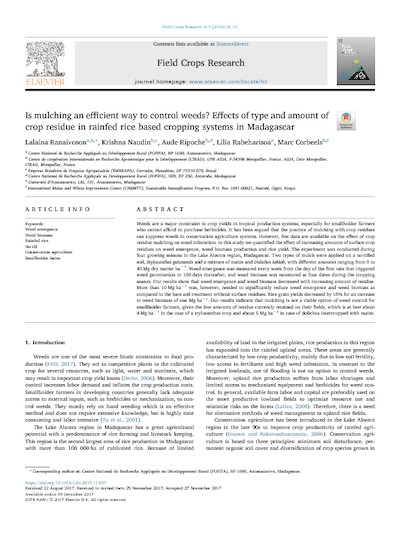. Soil acidification and declining fertility are widespread in sub-Saharan Africa. Nutrient depletion is mainlyrelated to nutrient mining driven by biomass removal without replenishment of nutrients through use of fertilisers. Concomitant acidification is due to the high ash alkalinity of harvested biomass. We determined the nutrient content andash alkalinity of biomass of the main crops produced in smallholder mixed crop–livestock farming systems in the Malagasy Highlands of Madagascar and calculated the soilacidification/alkalinisation occurring through biomass transfer. Samples of rice and forage were collected from 70 rice plots and 91 cultivated forage plots, and 70 manure samples were collected from farms. Nutrient exports induced by crop harvesting resulted in annual losses of 57 kg nitrogen (N), 6 kg (phosphorus) P and 33 kg potassium (K) ha–1 for rice (grain + straw), and 31–51 kg N, 8–9 kg P and 29–57 kg K ha–1 for each forage cut (with three cuts per year on average). The ash alkalinity of samples, calculated as the difference between cation and anion contents, was 49–100 cmolc kg–1 for forage crops, 31 cmolc kg–1 for rice straw, and only 4 cmolc kg–1 for rice grains. Biomass removal caused a loss of nutrients and an increase in soil acidity. Owing to low nutrient retention efficiency during the handling and storage of manure, the traditional input of manure at 5 t fresh matter ha–1 is insufficient to balance nutrient and alkalinity losses in Malagasy mixed crop–livestock farming systems. Maintaining productive and sustainable mixed crop–livestock farming systems requires greater attention to ensuring a nutrient balance at both plot and farm levels.
Biomass harvesting leads to soil acidification: a study of mixed crop–livestock farming systems in Madagascar
Is mulching an efficient way to control weeds? Effects of type and amount of crop residue in rainfed rice based cropping systems in Madagascar
Weeds are a major constraint to crop yields in tropical production systems, especially for smallholder farmers who cannot afford to purchase herbicides. It has been argued that the practice of mulching with crop residues can suppress weeds in conservation agriculture systems. However, few data are available on the effect of crop residue mulching on weed infestation. In this study we quantified the effect of increasing amounts of surface crop residues on weed emergence, weed biomass production and rice yield. The experiment was conducted during four growing seasons in the Lake Alaotra region, Madagascar. Two types of mulch were applied on a no-tilled soil, Stylosanthes guianensis and a mixture of maize and Dolichos lablab, with different amounts ranging from 0 to 45 Mg dry matter ha−1 . Weed emergence was measured every week from the day of the first rain that triggered weed germination to 100 days thereafter, and weed biomass was monitored at four dates during the cropping season. Our results show that weed e


